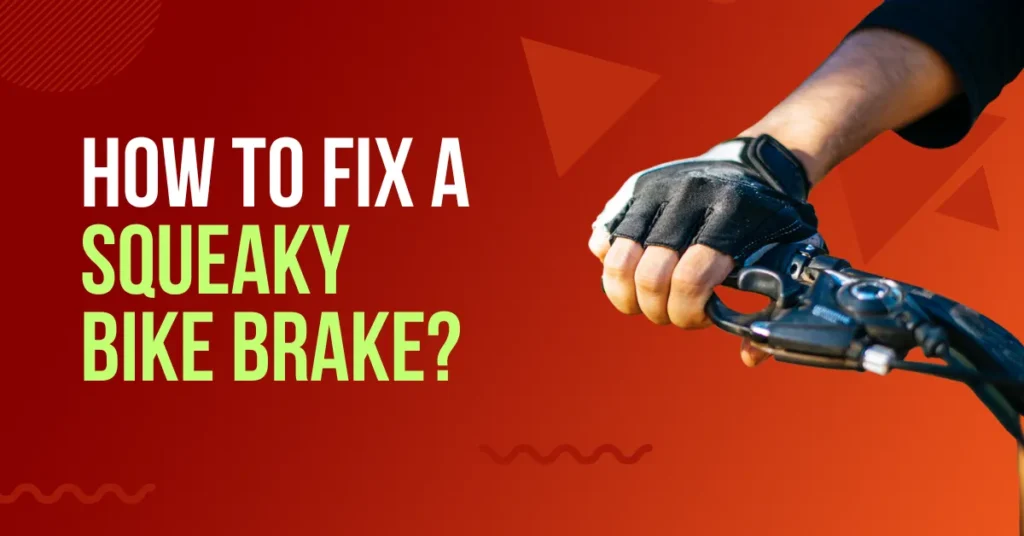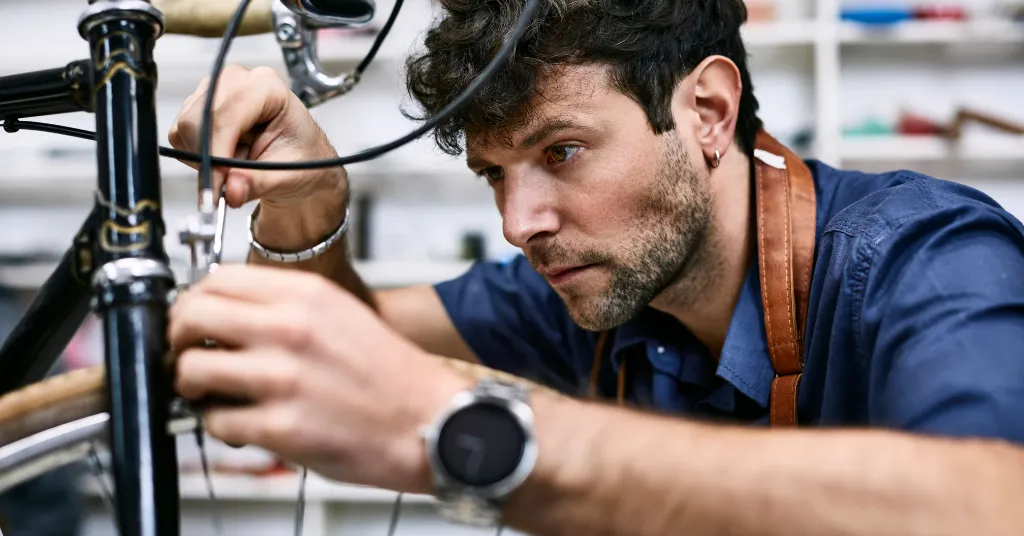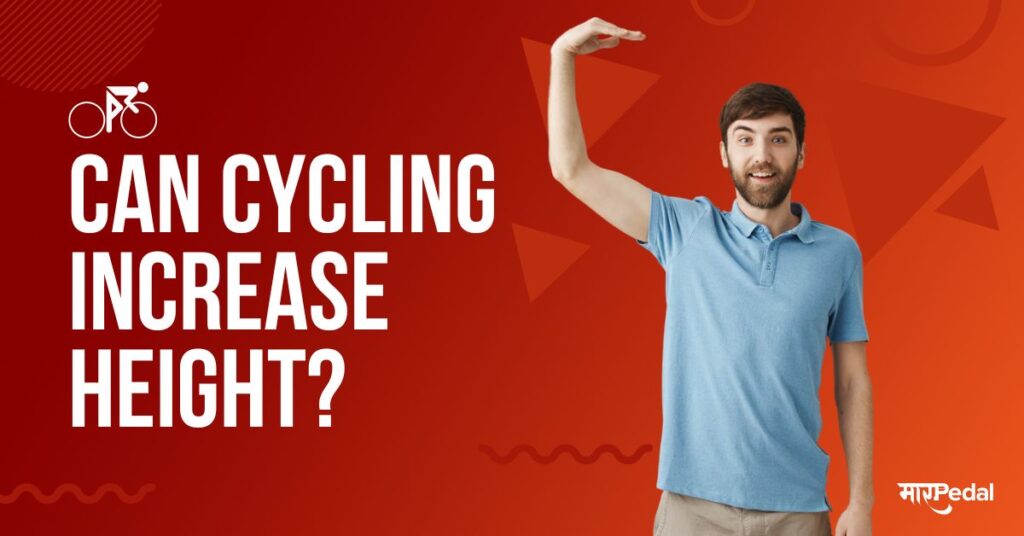
A squeaky bike brake can be annoying and potentially dangerous. Thankfully, a squeaky brake is usually an easy fix—often requiring just a quick adjustment or lubrication. With a few tools and a little know-how, you can quickly silence a noisy brake and get back to safe and quiet riding.
What Causes a Squeaky Bike Brake?
Before fixing a squeaky brake, it helps to understand what’s causing the noise in the first place. Here are some of the most common culprits behind noisy brakes:
Contaminated Brake Pads
Over time, brake pads can become covered in oil, grease, or dirt. These contaminants prevent the pads from making full contact with the rim. The result is a high-pitched squealing or squeaking noise when you pull the brake lever.
Worn Brake Pads
Brake pads wear down with use. If they wear down too much, the pad material can separate from the backing plate. This allows the metal backing to contact the rim, causing squeaking and reduced braking power. Time to replace them!
Improperly Aligned Brakes
If the brake pads aren’t hitting the rim cleanly and evenly, braking power is reduced. The pads can vibrate against the rim, causing annoying squeaks and squeals. Proper brake alignment is key.
Loose Brake Mounting Hardware
The brake caliper must be securely attached to the frame/fork in order to operate properly. If bolts are loose, the caliper can wobble while braking. This leads to uneven pad contact and noise.
Rust Buildup
Excessive rust on the brake surfaces can prevent smooth operation. Flaky rust getting between the pads and rim is a prime cause of squeaking.
Weather Conditions
Cold, wet weather can lead to squeaky brakes. Water, road grime, and salt buildup prevent smooth braking. Thankfully, this cause of noisy brakes is temporary.
See also: What to Wear Cycling – Choosing the Right Gear for Every Weather Condition
Improper Bedding-In
New brake pads and rotors should be “bedded in” prior to heavy use. This helps transfer an even layer of pad material onto the braking surfaces. Skipping this step can lead to uneven transfer and squeaking.
How to Diagnose the Cause of a Squeaky Brake

Before attempting to fix a squeaky brake, take a moment to diagnose the specific cause. This saves time and frustration. Here’s how to pinpoint the culprit:
Inspect Brake Pads
Examining the brake pads is the first step in diagnosis. Look for contamination, uneven wear, glazing, cracks, or complete wear-through. Any of these indicate the pads need cleaning or replacement.
Check Hardware
Grab the brake caliper and wiggle it to detect any looseness. While squeezing the brake lever, look for the caliper moving unevenly, indicating misalignment. The rotor should spin freely through the caliper.
Test Braking
Roll the bike and apply the brakes at various speeds, listening for where the squeak occurs. Squeaking at low speeds indicates contamination. High-speed squeaking points to glazing or improper bedding.
See also: How to Tighten Brakes on a Bicycle 🔧
Consider Environmental Factors
Does the squeak only happen during/after wet weather riding? If so, contamination is likely the cause. Have the pads been used heavily recently? Possible glazing. Take conditions into account.
Locate the Noise Source
Isolate whether noise emanates from the front or rear. Then pinpoint if it’s coming from the pads, rotor, mounting hardware, or another component. This helps troubleshoot further.
Assess Wear
Inspect pads and rotors for excessive wear. Hold pads up to the light—if you can see through them, they’re worn out. Use a ruler to measure rotor thickness against manufacturer limits.
How to Clean Contaminated Brake Pads

If contaminated pads are confirmed or suspected as the cause of squeaking, here are ways to clean them:
Using Isopropyl Alcohol
- Apply isopropyl alcohol to a clean rag.
- With wheels removed, wipe the pad surfaces to remove oil, grease, or other contaminants.
- Allow pads to fully dry before reinstalling wheels and testing brakes.
With Sandpaper
- Remove wheels to access pads.
- Use fine grit sandpaper to lightly sand pad surfaces.
- Sand just enough to expose fresh pad material underneath.
- Avoid completely removing the top layer of pad friction material.
By Burnishing
- Burnishing heats and cleans pads through brake use.
- Accelerate bike to a moderate speed. Apply firm, sustained pressure to brake levers for 30 seconds.
- Repeat process 3-5 times. Allow pads to cool between cycles to avoid overheating.
- This should transfer and burn off contaminants. Test braking afterwards.
When Changing Pads
- Always start fresh with new, clean pads when replacing worn pads.
- Never reuse old pads as contaminants linger in the friction material.
How to Fix Misaligned Brakes
Brakes must be properly aligned to allow the pads to contact the rotor cleanly. Here’s how to realign squeaky disc brakes:
Assess Current Alignment
- Spin the wheel and look at spacing between each pad and the rotor. They should be equidistant.
- If one pad is closer than the other, loosen the caliper mounting bolts and realign.
Center the Caliper Over the Rotor
- With mounting bolts loosened, push the caliper so it’s centered over the rotor.
- Ensure pads are equidistant from rotor on each side.
Tighten Mounting Bolts
- With the caliper centered, tighten the mounting bolts to specification with a torque wrench.
- Do not over tighten, as this can warp the rotor. Refer to manufacturer torque specs.
Recheck Alignment
- After tightening bolts, spin the wheel and double check even pad spacing to the rotor.
- Apply the brake and check that the caliper isn’t pulling to one side.
Consider Adding Spacers
- If one pad remains closer despite realigning, caliper mount spacing issues may exist.
- Adding thin spacers between the caliper mount and frame can even out alignment.
How to Fix Loose Brake Mounting Hardware
Loose brake mounting bolts are a common cause of annoying brake squeal. Here’s how to secure any loose parts:
Inspect Bolts and Torque
- Try tightening mounting bolts first, as they may have simply vibrated loose over time.
- Use a torque wrench to tighten bolts to the proper manufacturer torque specs.
- If bolts are already tight or still loosen quickly, further action is needed.
Clean and Apply Threadlocker
- Loosening old bolts allows you to clean the threads and apply threadlocking compound.
- Remove loose bolts one at a time, clean threads with a wire brush, apply threadlocker, then reinstall and tighten.
- Let threadlocker cure fully before operating brakes. This keeps bolts securely in place.
Replace Bolts if Needed
- If bolts are bent, corroded, or damaged, they must be replaced with new OEM-spec hardware.
- Carefully match bolt size and length. Use stainless steel hardware if possible.
- Lubricate threads with grease during reassembly to prevent seizing.
Check for Worn Parts
- If mounting bosses or holes are damaged or elongated, worn frame tabs, bolt hangers, or brake mounts may need replacing.
- This often requires removing the component, installing a new part, and realigning everything.
How to Fix Squeaky Brakes from Rust Buildup
Rust is enemy number one of smooth, quiet braking. Here are some tips for addressing squeaks caused by rust:
Clean and Sand Affected Areas
- Remove any loose rust flakes with isopropyl alcohol and a rag.
- For more substantial buildup, use emery cloth or fine sandpaper to remove rust from pads, rotors, and mounting hardware.
Prevent Rust from Returning
- Apply a corrosion inhibiting spray or grease to cleaned metal components.
- Address any damaged frame or component coatings that are allowing rust to form.
- Store your bike inside or under cover whenever possible to limit rain exposure.
Replace Heavily Rusted Parts
- Rotors, pads, cables, and bolts with heavy rust may need complete replacement if sanding doesn’t fix squeaking. Don’t take chances with braking performance.
- Swapping to stainless steel hardware can help resist future rust buildup in some components.
Consider a Professional Frame Restoration
- If the bike frame itself has extensive rust, a professional rust removal and paint restoration service can help mitigate noise and future damage.
- This is worth considering for a treasured bike with significant rust issues.
How to Fix Brake Squeaks Caused by Weather
Rain, snow, salt, and other winter weather riding hazards can lead to temporary brake squeaking. Try these tips:
Regularly Rinse off Brake Components
- Use a damp rag to wipe road grime and salt residue off rotors, calipers, pads, and hardware after wet rides.
- Spray water directly onto components while spinning the wheel to flush out grime. Dry thoroughly.
Avoid Riding Right After Rain/Snow
- Let roads fully dry before your next ride. Lingering moisture worsens contaminant pickup in brakes.
- Briefly apply brakes during your ride once dry to burn off any initial moisture buildup.
Lubricate Caliper Sliders and Pistons
- Use silicon or PTFE spray lube on caliper sliders and pistons to prevent sticking and uneven pad wear from road grime. Don’t get lube on pads or rotors!
Switch to All-Weather Brake Pads
- Pads made for wet conditions resist noise by transferring material more evenly in moisture.
- Swap pads seasonally for quieter braking in winter weather.
How to Bed-In New Brake Pads and Rotors
Bedding-in fresh brake pads and rotors is key to preventing squeaks. Here’s how:
Accelerate to Moderate Speed
- Start by getting up to about 20 mph then safely easing on the brakes to scrub off speed.
- Don’t brake too aggressively on initial cycle—just moderate pressure.
Repeat with Progressively Harder Braking
- Complete 8-10 increasingly harder braking cycles, allowing components to cool briefly between each.
- Final cycles should involve very firm pressure, nearly locking up the wheel.
Final Heating Phase
- Finish by accelerating to 30+ mph then braking very hard for 30 seconds, without fully locking up.
- This final heating phase transfers a smooth pad layer onto the rotor surface.
Allow to Cool Completely
- Let brakes cool fully before any further riding to prevent damaging the components.
- The bed-in process can produce some initial squeaking but should make the brakes quieter long-term.
How to Fix Specific Brake Noises
Beyond general squeaking, here’s how to address some specific brake noises:
Squeal at Low Speeds
- Indicates contaminated pads. Clean them thoroughly with isopropyl alcohol or sandpaper.
High-Pitched Squeal When Braking
- Often caused by hardened, glazed pads. Sandpad surface or replace pads to expose fresh material.
Metallic Squealing
- The pad backing plate is contacting the rotor, indicating completely worn pads. Replace pads immediately.
Grinding or Scraping Noises
- Typically caused by a loose caliper or hardware. Tighten all mounting bolts and check alignment.
Rubbing Sound When Not Braking
- A stuck caliper piston can cause constant pad contact on the rotor. Lubricate the pistons and slider pins.
DIY vs Professional Mechanic
While many brake squeaks can be remedied at home, consider taking your bike to a professional bike mechanic in these cases:
- If brake mounting hardware needs replacement
- When the rotor is bent and needs truing
- If the wheel hub bearings are damaged
- If brake pads are completely worn through or damaged
- For hydraulic brake bleeding, hose replacement, or other fluid system repairs
- If the cause of noise cannot be resolved after thorough troubleshooting
Top Tips for Quieter Brakes
Follow these tips for keeping your bike brakes operating smoothly and quietly:
- Regularly clean rotors and pads with isopropyl alcohol
- Check pads and rotors for wear before they get too thin
- Lubricate caliper mounting bolts and contact points
- Avoid oil-based lubes getting on brake surfaces
- Bed-in new pads and rotors properly
- Use higher quality brake pads for reliable performance
- Store bike indoors to prevent rust buildup
- Rinse off brakes after wet rides
With the right diagnosis and a few simple repairs, you can stop annoying brake squeal in its tracks. Just be sure to prioritize brake safety first—a little noise is a small price to pay for reliable stopping power. Safe, quiet riding ahead!
FAQs About Fixing Squeaky Brakes
What is the main cause of squeaky bike brakes?
The most common causes of squeaky bike brakes are contaminated brake pads, worn pads, misaligned brakes, loose hardware, rust buildup, weather conditions, and improper bedding of new components.
Should I replace or clean squeaky brake pads?
You can try cleaning contaminated brake pads first with isopropyl alcohol or sandpaper. If that doesn’t work, or the pads are worn out or damaged, replacement is needed.
How do I stop brake squeal in wet weather?
Regularly rinse off brake components after wet rides, lubricate caliper sliders, and consider using all-weather brake pads to minimize wet weather squealing.
Why do my brakes squeak after replacing the pads?
New pads and rotors should be bedded in properly with a series of hard stops to transfer material smoothly. Squeaks immediately after pad replacement are common until bedded in.
Can I fix brake squeal myself or should I go to a bike shop?
Many common causes of squeaky brakes can be fixed at home. But take it to a professional mechanic if significant disassembly or part replacement is needed.
Conclusion
The soundtrack of your bike ride should be the wind and wheels, not annoying brake squeaks. With proper diagnosis and a few simple mechanical corrections, you can stop brake squeal in its tracks and get back to quiet, carefree cycling. Just don’t neglect brake safety and performance in favor of silence. Care for your brake system regularly, and it will return the favor with miles of maintenance-free operation.






